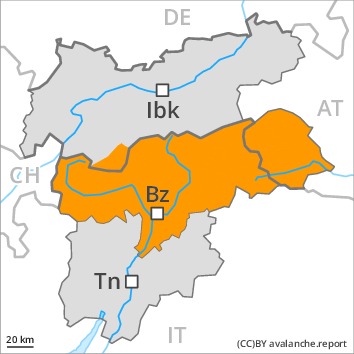
Danger level
 | treeline
|
Avalanche Problem
 | | Wind-drifted snow |
|  | |  |
 | | Gliding snow |
|  | |  |
 | | Persistent weak layer |
|  | |  |

A critical avalanche situation will persist in some cases.
High altitudes and the high Alpine regions: The fresh snow and in particular the sometimes deep wind slabs can be released easily, or, in isolated cases naturally in all aspects. The number and size of avalanche prone locations will increase with altitude. On extremely steep sunny slopes individual loose snow avalanches are possible. Avalanches can also penetrate deep layers and reach dangerously large size. Weak layers in the upper part of the snowpack can still be released in some places by individual winter sport participants in particular in areas where the snow cover is rather shallow.
Low and intermediate altitudes: A substantial danger of gliding avalanches exists. Areas with glide cracks are to be avoided as far as possible.
In the regions exposed to heavier precipitation the avalanche prone locations are more prevalent and larger. Extensive experience in the assessment of avalanche danger is required.
Snowpack
dp.6: cold, loose snow and wind
dp.2: gliding snow
20 to 40 cm of snow, and up to 70 cm in some localities, has fallen since Saturday above approximately 1800 m. The fresh wind slabs are lying on soft layers in all aspects above the tree line. The snowpack is moist, in particular at low and intermediate altitudes.
Avalanche prone weak layers exist in the centre of the snowpack in all aspects, in particular above approximately 2000 m.
Tendency
Fresh wind slabs require caution. In addition a latent danger of gliding avalanches exists.











